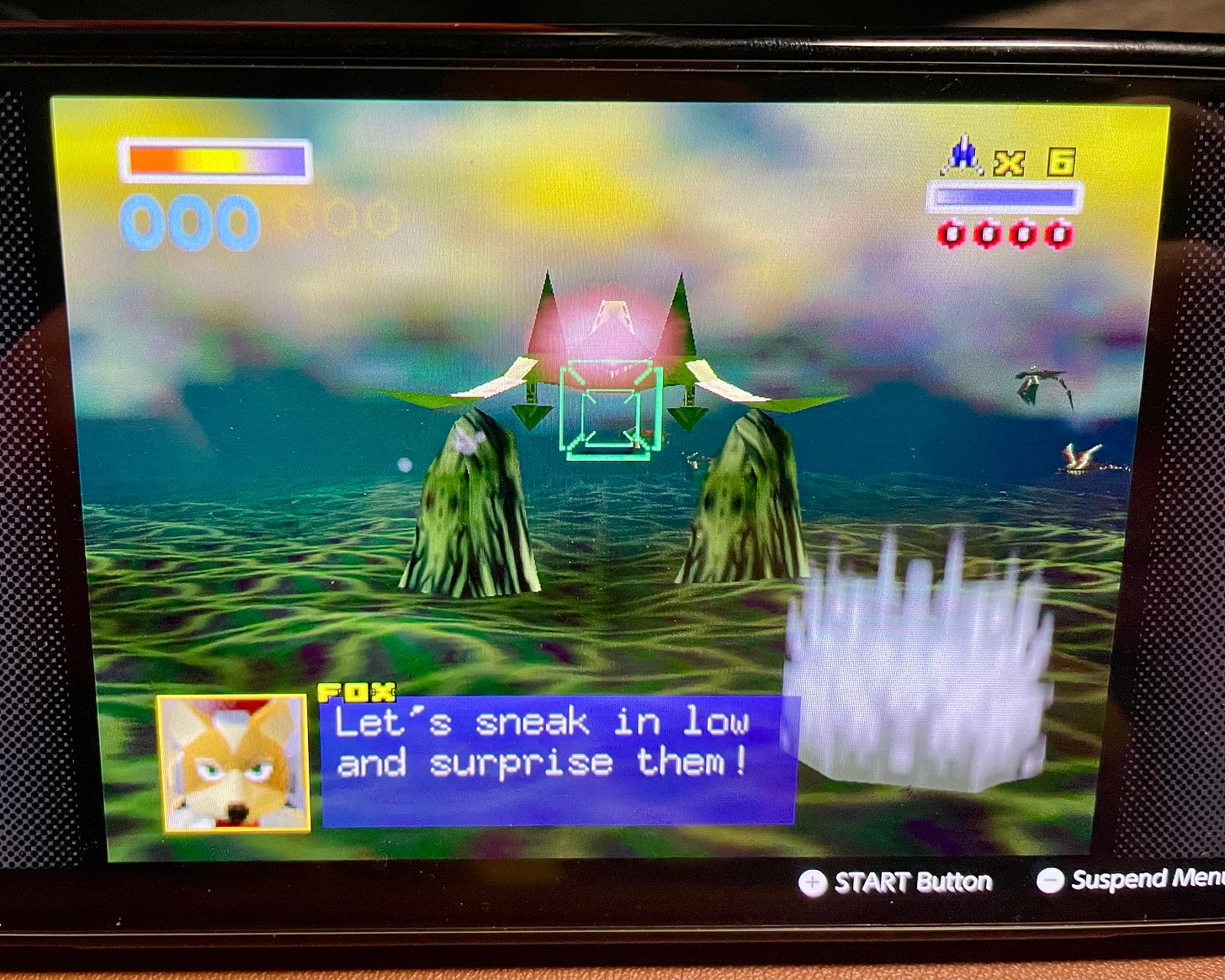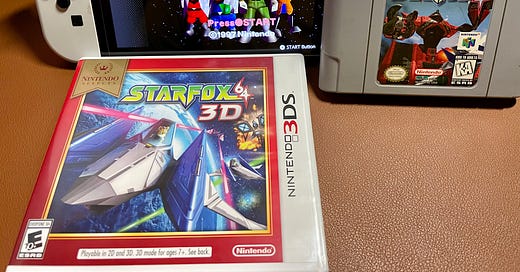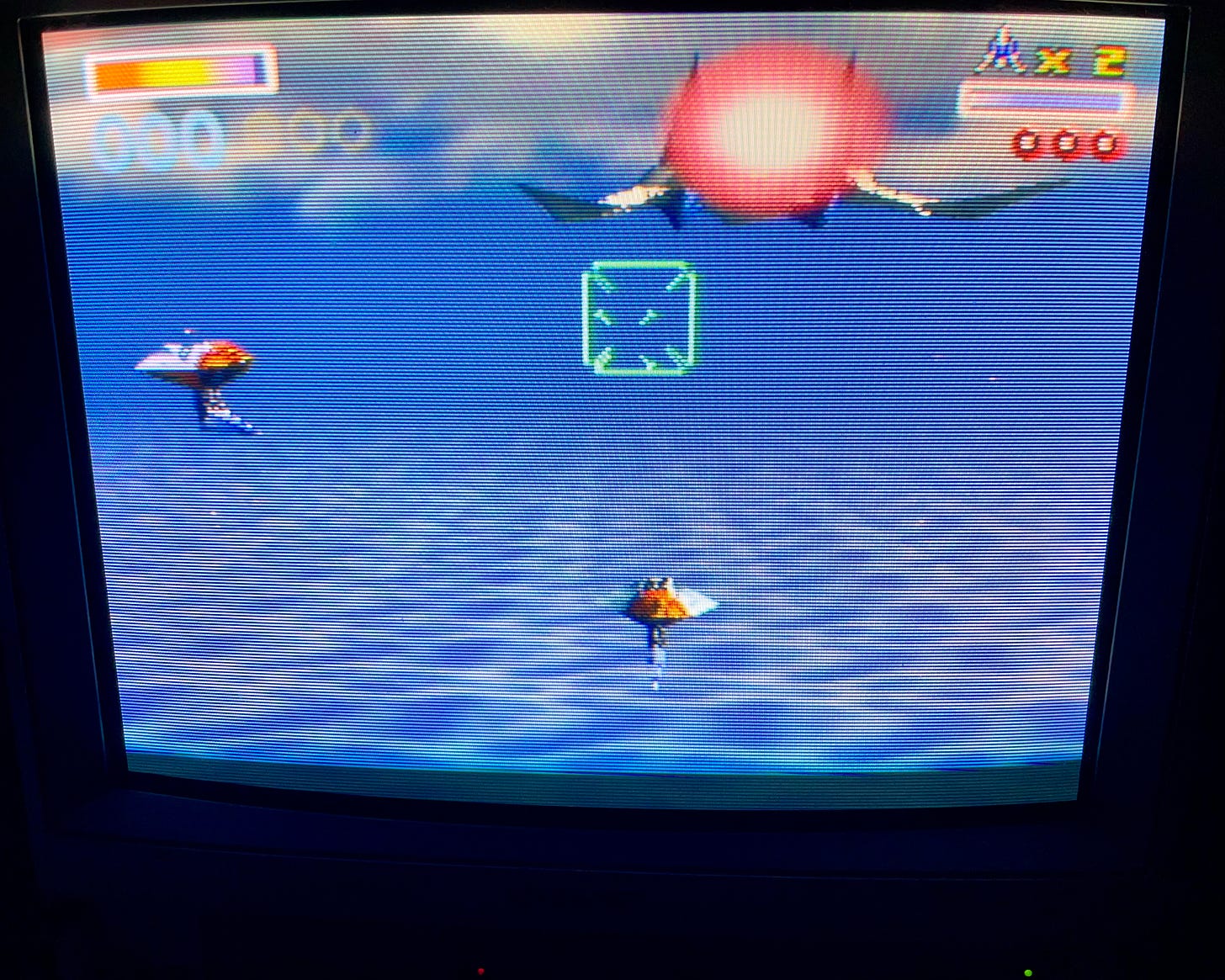Star Fox 64, also known as Lylat Wars in Europe, is one of my favorite games on the Nintendo 64. For those born in the late 80s and early 90s, it's hard to find someone who has yet to play this game. By the time Star Fox 64 was released in 1997 for the Nintendo 64, Super Mario 64 had already changed three-dimensional gaming. Goldeneye 007 was a massive step forward for first-person shooters on consoles, and hype was building for The Legend of Zelda: Ocarina of Time. The late 90s was an excellent time to be a Nintendo fan, and Star Fox 64 added to Nintendo's already excellent library of games.
I remember getting Star Fox 64 at the start of the 1998 summer. At that time, my parents always bought me a new Nintendo game if I did well in school. That bribery always gave me the motivation to do well. If you’re a parent trying to incentivize your children, don’t forget to offer them bribes for performance. It works! Star Fox 64 came in a very thick cardboard box because it also came with a brand-new piece of immersive technology, the Rumble Pak! The Rumble Pak was designed to be inserted in the bottom of the N64 controller and provide force feedback to the player in response to actions on the screen. It was a game changer, literally, and almost every controller that has been released since has had rumble capabilities.
Star Fox 64 is a sequel to the Super Nintendo game Star Fox, which, in its way, was also a game changer. Star Fox utilized a Super FX coprocessor attached to the cartridge circuit board, which gave the Super Nintendo the power to display polygons. The original Star Fox was one of the most remarkable games of its time, but I don’t think it holds up well today. Regardless, the original Star Fox performed very well, and Nintendo quickly began work on a sequel, creatively titled Star Fox 2.
Star Fox 2 also utilized the Super FX coprocessor further to push the graphical capabilities of the Super Nintendo. The development team spent three years working on Star Fox 2, only to have it canceled when it was 95% complete because Nintendo wanted to reallocate resources away from the Super Nintendo in favor of the Nintendo 64. For many years, fans were curious about Star Fox 2, and although a few alpha and beta versions of the game were leaked on the internet, there were still many questions about the game. In 2017, however, fans had all their questions answered when Nintendo released a complete version of Star Fox 2 on the Super Nintendo Classic mini console.
After the original cancellation of Star Fox 2, the team shifted to making a Star Fox adventure on the Nintendo 64. This new game utilized the 64-bit system's horsepower to make something that never could have existed on the Super Nintendo, no matter how much power the Super FX chip had. The Nintendo 64 had better graphics, sound, and presentation, and the new rumble pak made it feel like you were in the middle of the action.
The development team decided that Star Fox 64 would not be a new adventure but a reboot of the series, despite the series only consisting of a single game. Rather than continuing the story of Fox McCloud and his gang after the defeat of Andross, Star Fox 64 takes us back to the beginning again. Andross threatens to conquer the Lylat system with his vast army, and Star Fox is hired to stop his imperialistic ambitions. If you think it's any more profound than the original game because it's a reboot, it simply is not. There's more dialogue between Fox and his crew when you're all in the middle of the action, but there's still minimal expository narrative or meat to the story. The premise is simple; you are Fox McCloud, you fly a starfighter, now liberate the solar system from Andross. Only at brief moments does it feel that this game yearns to be something more, like when you're on planet Katina during the mission that was in no way inspired by the movie Independence Day. Fox reunites with his old buddy Bill; they say hi and help each other, and that's all you hear from Bill. The same applies to this female space fighter called Katt, whom Falco seems to have some affiliation with. These prior relationships are never expanded upon, and one wonders if it was due to time restraints or something. I don’t think the story suffers from the lack of background or character development, but it’s curious when moments like that come up during the game.
Star Fox 64 is a straightforward game, but it still has depth in its mechanics and many reasons to continue playing after beating the game once. Star Fox 64 was designed to build on the ideas of the 1993 original game while incorporating new mechanics from a previously unreleased Star Fox 2. As a result, the game feels like a hybrid of the first and second Star Fox games with beefed-up production values. Players progress through different stages, such as in Star Fox 1. However, now they can command the Landmaster, a battle tank, or the Blue Marine, a submersible vehicle. The Arwing, equipped with a charge shot, a third-person aiming reticle for better accuracy, a barrel roll that deflects lasers, and an all-range mode, is the primary vehicle used throughout the game. There are also upgrades to weapon strength, silver rings are health pickups, and flying through golden rings can increase a player's health for the remainder of a stage. However, losing the Arwing’s wings due to taking too much damage is still a significant threat. Flying with damaged wings is very difficult and always painful when it happens.
Star Fox 64 has a more consistent frame rate, distinguishable models, textures, and better graphical effects than the original Super Nintendo game. It looks great, with everything the previous game lacked. However, some players may still prefer the original game's soundtrack, as the militaristic approach with rapid percussion and brass in Star Fox 64 can be forgettable. Some planets, such as Aquos, also seem too dark, despite the intention. Others, such as Solar, appear vibrant on the original N64 release but dull when playing on the Switch’s Online Service.
The challenge level is perfect. As you start your adventure, you have time to learn the basics, and the difficulty curve gradually increases as Fox advances toward the final battle on planet Venom. It doesn’t spike from 10 to 100 on a moment's notice. It’s not exactly a cakewalk, but it never feels impossible. Even taking this game’s most challenging path, there is a bit of trouble here and there, but you never stop feeling like you can overcome the odds. Some of the boss fights are a little intense, like the final battle against Star Wolf, which is the most brutal encounter in the game. But, throughout the journey, I was pleasantly surprised at how comfortable the majority of the game was.
I could have gone without the Landmaster and Blue Marine sections. They're only in three of the fifteen stages, but they are noticeably lower quality than the missions that have you piloting the Arwing. The Blue Marine stage is a real grind, and the graphics tend to slow down due to lag. I find it difficult to aim my shots with the Landmaster turret because the rough terrain repeatedly moves my aiming reticle.
The game’s true challenge isn’t derived from the opposition thrown at you or what vehicle you're piloting but rather from figuring out how to reach different planets in the Lylat system. With a couple of exceptions, every stage has a specific mission objective. And if you meet the requirements, you can continue your current route. You will be headed along an alternate path if you fail to accomplish the mission. The mission objective is occasionally apparent, such as defeating Star Wolf before the bomb goes off or stopping the train from reaching the supply depot. Other times it's incredibly opaque like if you want to reach Aquos, you have to kill over 100 targets in Sector Y. I don't think the game highlights the mission objectives very clearly, but often your teammates the key to figuring out how to complete these goals. To this game's credit, they're much better this time around.
I enjoy all the conversations between the members of Star Fox. As a kid, I was fascinated that a game could be fully voiced, even if the acting was comically over-the-top. Aside from some scripted conversations, your teammates mostly ask for your help to destroy a bogey on their tail or, infamously, to “Do a Barrel Roll.” As far as your teammates go, however, they’re often more of a hindrance than a help. The other members of Star Fox must be some of the worst pilots in the solar system because they are always on the verge of getting shot down, and it doesn't help that you're now capable of hitting them yourself with your lasers, prompting a “Hey, wise guy, I’m on your side, remember?”. Saving them does have benefits other than a higher score. They can help locate power-ups for your ship and clear specific obstacles to make things easier. They can highlight the boss’s weaknesses and help you complete the mission objective. So it’s best to keep them alive even if you don't want to at times because, let's face it, Slippy's accident-prone, Peppy's advice quickly wears thin, and Falco's a massive asshole.
I love how other forms of assistance can show up when I take specific routes. It's a great way to increase replayability, and given how short the game is, that's a good thing. Completing a whole route in Star Fox 64 takes about an hour, but reaching every stage takes about three hours. I still have a fantastic time sitting down and playing this game. Star Fox 64 knows what it’s good at and simply does it. It is an exceptionally tightly wrapped video game that you can sit down, grab that controller, and have fun with.
When the game first came out, it was a sight to behold to my seven-year-old eyes. Every stage in All-Range Mode was an energetic thrill, and the game still holds up impressively well today. My favorite stage is Area 6. Team Star Fox races through Andross's final wave of defenses while listening to the opposition continuously panic that you're destroying everything. All stages have something unique to offer, and while they aren’t all amazing, the good parts are more than good enough to make up for the mediocre parts. It's a thoroughly exciting journey from Corneria to the final boss battle against Andross. If you feel the need to challenge yourself further, you could go the extra mile and earn gold medals for achieving a higher-than-average kill count, and trust me, that requires a lot of killing. In many, many years of playing this game, I’ve only accidentally got two or three gold medals.

Star Fox 64 is also available on the Nintendo Switch Online + Expansion Pack, but if there's one version I recommend above all others, it's the 2011 remake on the Nintendo 3DS, Star Fox 64 3D. Consider getting this version if you have a 3DS or 2DS because it is, hands down, the best version of the game. The updated graphics are a significant plus; this remake looks and sounds fantastic. Also, controls have been vastly improved since the N64 original. Moving with the 3DS circle pad feels silky smooth when controlling the Arwing, the Landmaster, and the Blue Marine. You can also use the built-in gyro controls. I’ve never felt comfortable with gyro controls, but I know some people rave about them, so to each their own. Regardless, you have both options, so that's a significant plus. The original Star Fox 64 doesn't control badly. It’s perfectly fine, but it’s subjected to the limits of a controller released in 1996. In the 3DS version, if you can't complete a route in under an hour, you can choose to save your progress. In the N64 original, there’s no way to save your game, but I’ve never really found that to be a problem because of how short the campaign is.
On the off chance you haven't already played this twenty-six-year-old game, you can’t go wrong whichever way you choose to play Star Fox 64. It doesn't have much in the story department, it just has a setup, but that's all it needs.






